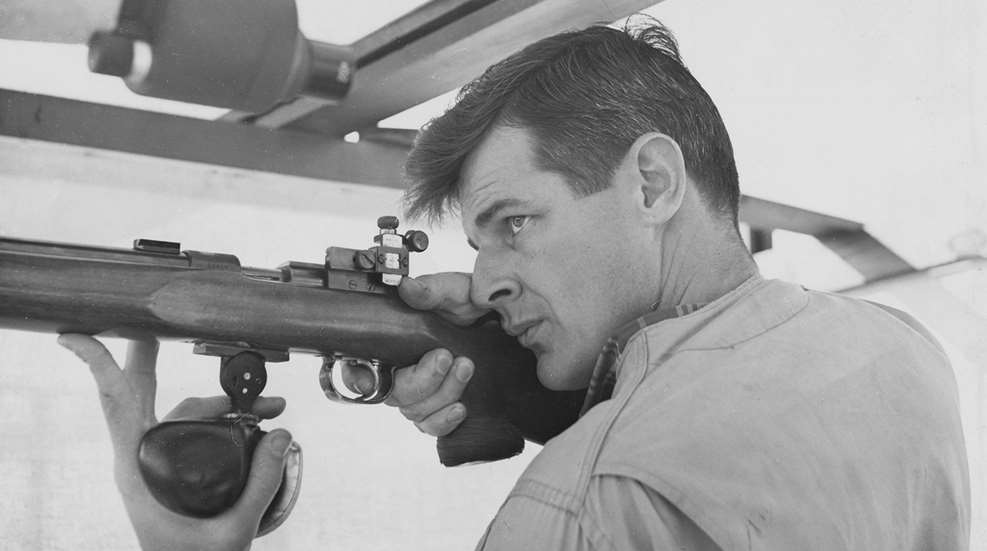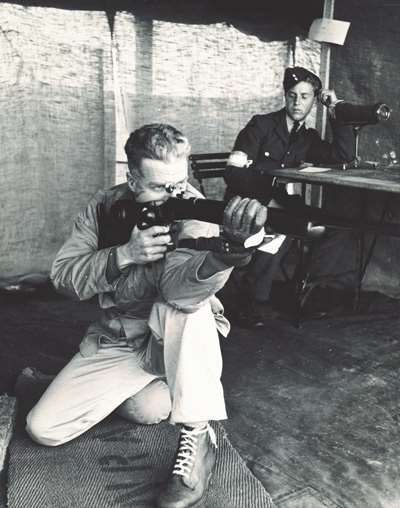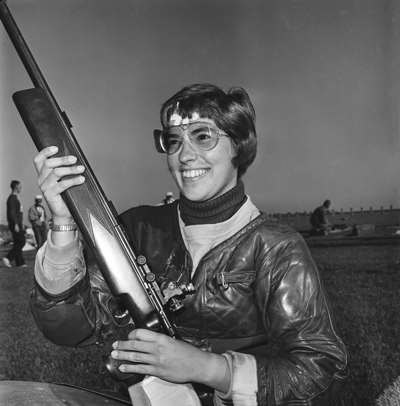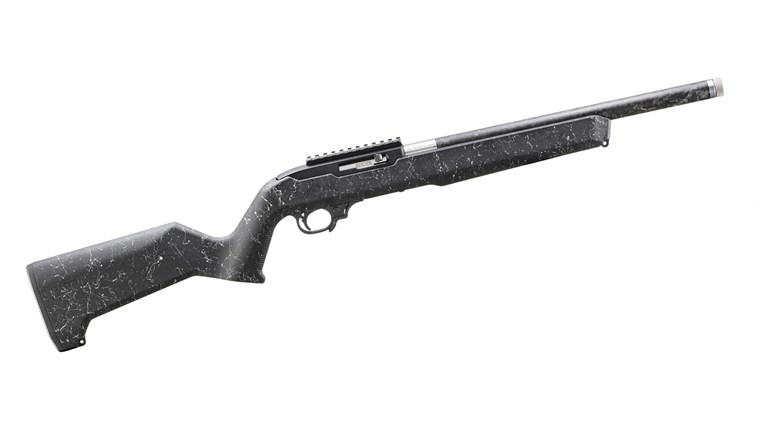
Pictured above is Arthur Jackson—Olympian (1948, 52, 56), World Smallbore Prone Champion (1949, 52), President’s Match winner (1951) and one of America’s outstanding marksmen.
After the United States withdrew from International Shooting Union (ISU) sanctioned competition (now the International Shooting Sport Federation, ISSF) in 1930 U.S. international shooting was confined to the annual Dewar Team match and the Pershing Team competition, all smallbore prone shooting.
Back on the Scene
The U.S. re-entered ISU-international shooting in the 1948 London Olympics. Frank Parsons reported in the American Rifleman that “. . . our team was tackling three out of the four Olympic shooting events with improper or inferior equipment.” Only in the 50m (60 shots) smallbore prone match were we competitive.
In the 300m 3 position (3x40) competition, Emmet (“Doc”) Swanson and Frank Parsons used the Martini free rifles they had shot in the 1930 World Championships—with left over 1930s ammunition. Arthur Jackson used a Winchester Model 70 bull gun and his own reloads. Unfortunately, Parsons’ Martini barrel was so badly worn that it was unusable, so he used Doc’s rifle on the off-relay.

A lot had changed during the 18-year absence of the U.S. team; the pads on their shooting coats were illegal, causing an emergency shipment of Marine Corps coats that could be modified to be legal. Additionally, the rules for the kneeling position now required that the shooter place a 4 or 6 inch diameter cushion under the instep of the right foot (right handed shooter), a position universal today but unheard of in the U.S. in 1948.
However, at the 1948 London Olympics Doc Swanson was the high U.S. shooter with a 1079, good for tenth place—a score seven points below his 1930 score. The smallbore shooters provided the brightest spot on the U.S. team: Art Cook won gold in the 50 meter prone match with a 599-43X, edging Walter Tomsen’s 599-42X. The third entry, Vaughn Cail, was four down for ninth place.
The following year, Swanson, Cook and Jackson, joined by Robert Sandager and August Westergaard formed the 1949 U.S. rifle team that went to the World Championships (WC) in Buenos Aires, Argentina. This event marked the first time a U.S. shooting team had flown to an overseas match. The quintet shot both 3 x 40 matches (50 and 300 meter) and the smallbore prone match (30 shots each at 50 and 100 meters).
The 300 meter team finished fifth with a 5404. Interestingly, the U.S. team’s 1930 World Championship score of 5441 would have placed fourth in 1949—three points ahead of Norway. The U.S. also placed fifth in the smallbore 3 x 40 (with Art Cook taking second) but was second in the 50 and 100 meter prone match with Art Jackson winning the only individual world championship with a 594 x 600.
Later World Championships told a similar story; in the 1952 matches (Oslo, Norway) the U.S. team (the five above plus Verle Wright) was fifth in the smallbore 3 x 40 team match; stage finishes ranged from third (prone) to seventh (standing). Doc Swanson was third in kneeling with a 392—10 points higher than his WC-winning score of 1930. At 300 meters our 3 x 40 team was again fifth with Doc Swanson and Bob Sandager both shooting 1102—the highest score ever shot by an American and good for eighth and tenth places. The U.S. won the 50 and 100 meter smallbore prone match and Art Jackson won his second world championship with a 596, with Verle Wright in second with a 595.
The Soviets Return
The 1952 Olympics, held in Helsinki, Finland, two weeks later, marked the return of the Soviet Union to the shooting events—the first Russian appearance since the 1912 Games. They took first and third in the 300 meter 3 x 40 (Anatoli Bogdanov raised the Olympic record to 1123) and third and fifth in the smallbore 3 x 40. Bob Sandager raised the American 300 meter record by two points to 1104, good for sixth. Art Jackson and Doc Swanson each shot 1155 in the smallbore 3 x 40, good scores by U.S. standards but 11th and 12th in Helsinki. In addition, Art Jackson had a 399 in the prone stage for the bronze medal.
The Russians dominated the 1954 World Championships in Caracas, Venezuela. Bogdanov and Vassily Borisov were first and second in both 50 and 300 meter 3 x 40 matches and the Russians won every team match (rifle and pistol) they entered—except two; the U.S. won the smallbore prone match (50 and 100 meters) and Sweden took the 50m 40 shot prone match relegating the Soviets to unaccustomed third places. At 300 meters, all of the five members of the Russian team fired higher scores than had ever been fired by an American. It was a remarkable performance that merited a substantial article in Sports Illustrated. The article’s prescription: Get up off our bellies and learn to shoot.
U.S. international shooters of the 1940s and early 50s cannot be faulted for devotion or dedication; they were the keepers of the flame that had burned so brightly in the 1920s, and they did it on their own dimes. All had full-time jobs, so they shot and trained when they could.
The 1954 matches also marked the introduction of the Anschutz smallbore match rifle. However, equipment was a problem: aside from smallbore prone, rifles that took advantage of the international rules were available only from Europe at considerable bother. Except for smallbore, ammunition was also a problem. Concurrently, U.S. shooters were forced to use Marine Corps coats, unless they made their own or imported them from Europe—while the Russians wore heavy leather shooting coats; but eventually equivalent coats would be made in the USA.
Over time, European standards had gone up but the same was not true for the U.S.—scores were respectable-to-outstanding in the 1920s, but not in the 1950s. The Russians had set out to prove that the communist system was superior to any other and were determined to achieve world domination in every sport including shooting. The Russian team reportedly got full pay for half work and half shooting. They had analyzed the shooting positions in the various events and had defined the only acceptable position for each discipline. The U.S. team had an “anything goes” attitude toward positions.
U.S. position shooting was almost exclusively an indoor smallbore proposition; there were scores of indoor leagues, but warm weather brought everybody out to shoot prone or high power. It wasn’t until 1957 that the first outdoor position Smallbore National Championship was held.
U.S. Rifle Renaissance
Despite this, there was help on the way. LTG Floyd L. Parks (USA), in a long and distinguished career, knew the utility of the rifle in war and was very much aware of the Cold War propaganda value of the Soviet dominance in shooting. He was also a good friend of President Dwight D. Eisenhower. In one of his last acts before retirement LTG Parks suggested that a serious effort be made to develop U.S. marksmanship skills. On March 1, 1956 President Eisenhower directed the establishment of the U.S. Army Marksmanship Unit (AMU). Their mission: “Beat the Russians.” As a result, the other services would ultimately establish their own marksmanship units.
The 1956 Olympics were in Melbourne, Australia; Dr. Emmet Swanson was team captain and Floyd Parks (former Executive Director of the NRA) was team leader, and he was also the U.S. representative at ISU meetings. Two AMU members were on the team: Verle Wright and Herbert Voelcker, both intercollegiate All-Americans (Indiana University and MIT). The All-American teams were to provide a major source of talent for future international teams. Unfortunately in 1956 the Russians dominated the awards—the lone U.S. medal was a free pistol bronze won by Offutt Pinion.
The 1958 WC matches were held in Moscow and, though the Russians still dominated, Verle Wright won two 300 meter championships: prone and kneeling (a world record) and was third in the smallbore standing match. Civilian Gordon Taras won bronze in the 50 meter prone match while AMU member Daniel Puckel was second in the 300m 3 x 40 match with an 1132. The U.S. took home a combined twenty medals.
At the 1959 Pan-American Games (Waukegan, IL) Art Cook won the 50 and 100 meter smallbore prone match and Dan Puckel won the smallbore and 300 meter 3 x 40 matches, the latter with a world record score of 1147. At the 1960 Rome Olympics, U.S. medals were won by Marines Bill McMillan (gold in the rapid fire pistol event) and Jim Hill (silver in the 50-meter prone match). In 1961 the NRA inaugurated the U.S. International Shooting Championships—a National Championship devoted to the courses of fire used internationally.
Thus, U.S. efforts began to pay off at the 1962 WC in Cairo, Egypt. Gary Anderson won four individual world championships, three with world records. Dan Puckel and Tommy Pool (AMU) were first and third at 300 meters standing; we medaled in pistol, shotgun and running deer. Counting all events we collected 30 team and individual medals. Sadly, the U.S. was still behind the Russians in the medal count (Russia had 37 medals), but no one could afford to ignore us.
At the 1964 Tokyo Olympics, Gary Anderson won the 300 meter 3 x 40 with 1153, raising the world and Olympic records by three and 16 points, respectively. Martin Gunnarsson (AMU) was third with 1136. In the 50m 60 shot prone smallbore (English) match, Lones Wigger tied for first with a world and Olympic record score of 597 but was outranked into second for the silver medal. Tommy Pool was third with a 596—also a record score. We medaled in pistol and shotgun. Lones Wigger shot a spectacular 1164 in the smallbore 3 x 40—15 points over the Olympic record and seven over Anderson’s world record shot just two years earlier. The U.S. won two gold, two silver and three bronze medals while the Russians had to settle for two silver medals.

The 1966 WC matches were held in Wiesbaden, West Germany, and confirmed that the U.S. had regained the fiery competitiveness of the 1920s. At 300 meters Gary Anderson raised his own 3 x 40 world record to 1156 (along with winning the smallbore 3 x 40 gold with 1153), and Jack Foster (AMU) raised the kneeling record to 391. The U.S. team (including Margaret Thompson, the first woman to shoot on a 300 meter team) won the team 3 x 40 championship with a record score of 4602. Don Adams (AMU) won the smallbore standard rifle event and the U.S. won the team event. D. I. Boyd (USMC) won the smallbore English match with a record 598 and the U.S. team (Boyd, Bill Krilling, Wigger and Adams) won the team event with another record score (2376).
We again medaled, team and individual, in pistol and shotgun events. In the women’s events Margaret Thompson won the 3 x 20 and took silver in the 60 shot prone match and the U.S. team won silver. Overall, the U.S. won a total of 29 medals, 17 gold, while the U.S.S.R. had 34 medals but only 10 gold.
And so began a time when the U.S. was once again a major player in international rifle shooting. The heroic efforts of the mostly civilian marksmen who kept things going in the 1940s and early 1950s had been supplanted, under the stimulus of a Cold War strategy, by a concentrated program to achieve competitiveness in the world arena. It was a joint effort: the military marksmanship units, the NRA and the U.S. shooting public.
This effort not only improved our international shooting but also changed domestic competition: U.S. rules now allowed the use of international equipment (e.g. palm rests, light triggers, shooting clothing) and international/metric targets, techniques and courses of fire and thus were inexorably making their way into the domestic shooting scene.


































